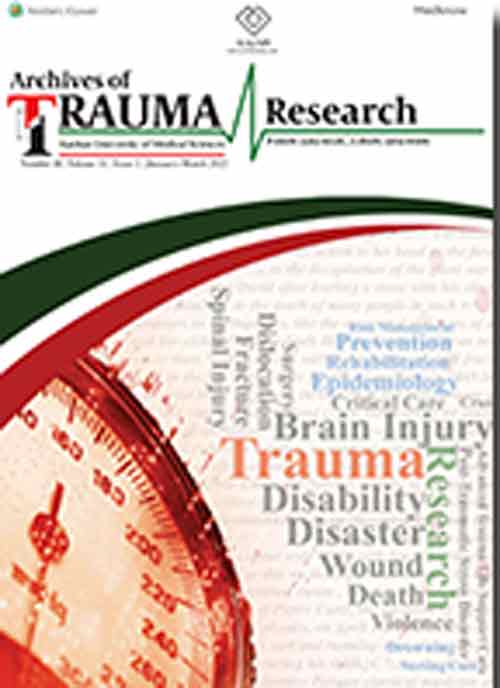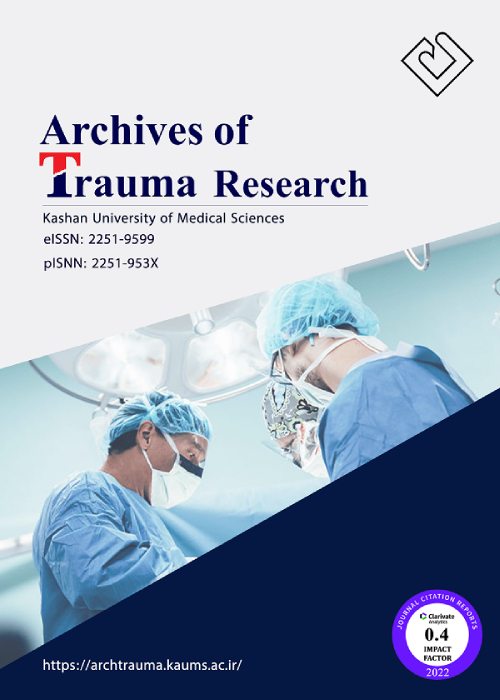فهرست مطالب

Archives of Trauma Research
Volume:11 Issue: 1, Jan-Mar 2022
- تاریخ انتشار: 1401/06/12
- تعداد عناوین: 10
-
-
Pages 3-8Introduction
Distal femur fractures are a common fracture seen in both high and low‑energy traumas in young and elderly patients. The standard of care in healthy, mobile, younger patients remains open reduction and internal fixation (ORIF) through various fixation devices. However, the standard of care for comorbid and elderly patients remains unclear. In these patients, rates of nonunion vary between 6% and 20%, requiring revision surgery. Our study sought to identify patients who have gone endoprosthesis conversion to a distal femur replacement following failed ORIF.
MethodsThis descriptive study includes a total of eight patients who underwent a revision distal femoral replacement (DFR) following failure of primary distal femur ORIF and data were gathered through chart review. Patient comorbidities, demographic characteristics, hospital disposition, complications, and mortality were collected and described.
ResultsThe average age of this cohort was 52.1 years, with 6 being female, and with a follow‑up mean of 3.02 years. The most common medical comorbidities present in these patients at the time of ORIF were diabetes, hypertension, obesity, smoking, and renal insufficiency. 87.5% of patients were able to tolerate weight bearing following DFR conversion, compared to 62.5% tolerating weight bearing before revision. Complications requiring revision surgery occurred in 3/8 patients, which included: aseptic loosening, prosthetic joint infection, and patellar maltracking.
ConclusionDFR in a revision setting following acute distal femur ORIF can be an acceptable treatment options with outcomes similar to primary DFR. Further investigation is warranted to determine optimal timing and indications for primary DFR in a fracture setting.
Keywords: Distal femur fracture, endoprosthesis, open reduction, internal fixation -
Pages 9-13Background and Objectives
Nonoperative management (NOM) of splenic injury is the standard treatment for all splenic injury patients who are hemodynamically stable. However, it may be a challenge in developing countries with limited intensive care resources. This study aimed to review the outcomes and identify the factors of unsuccessful NOM of splenic injury in a Level 1 trauma center in Thailand.
Materials and MethodsThis was a retrospective review that collected data from the trauma registry. The enrolled patients had a splenic injury and underwent NOM from 2009 to 2016. Failure of NOM was defined as the need for an operation on the spleen after NOM. The outcomes of NOM were described, and the predictors for failure of NOM were identified.
ResultsSeventy‑two splenic injury patients were included in the study. The majority of patients were involved in a motorcycle crash (56%). The average injury severity score was 20. Fifty‑nine patients (89%) were successfully treated as NOM. Six patients underwent embolization (8%), and none of the patients required operative management. Univariate analysis showed that hemoperitoneum in ≥4 regions (odds ratio [OR] 3.96, 95% confidence interval [CI] 0.79–25.53; (P = 0.05) and received packed red cells >2 units within 24 h (OR 20, 95% CI 2.15–242; P = 0.003) were significantly associated with failure of NOM.
ConclusionsNOM of splenic injury can be performed successfully in a trauma center in a developing country. Splenic angioembolization might be helpful to increase the success rate. The amount of hemoperitoneum was a significant predictor of failed NOM.
Keywords: Angioembolization, hemoperitoneum, splenic injury -
Pages 14-20Background and Objectives
Dental trauma is a common problem seen in children. Since schools are one of the main places where traumatic dental injuries (TDIs) occur, school health care providers have an important role to reduce the possible consequences. The study aimed at examining the awareness and attitudes of elementary school health‑care providers about the emergency management of TDIs in children.
MethodsThis cross‑sectional study was conducted on all health‑care providers of elementary schools in Kashan, Iran. Data were collected using a four‑part questionnaire. The collected data were analyzed using descriptive statistics (percentage, frequency, mean, and standard deviation) by the SPSS 26 software.
ResultsRegarding emergency management of traumatic dental injures, the scores of health care providers’ knowledge and health care providers’ attitude were 65% and 86.5%, respectively. There was no statistically significant association between the level of knowledge and a length of service, gender, and the educational level.
ConclusionsThe elementary school health‑care providers did not have a high level of awareness about how to deal with TDIs.
Keywords: Attitude, knowledge, tooth avulsion, tooth injuries, trauma -
Pages 21-25Background and Objectives
Perineural dexmedetomidine as an adjuvant of local anesthetics has been used in regional anesthesia to prolong the duration of analgesia. This study aimed to assess the effects of perineural injection of dexmedetomidine alone on the duration of postoperative analgesia, narcotic consumption, and hemodynamic changes in the patients undergoing upper limb surgery under general anesthesia.
MethodsSixty patients undergoing upper limb surgery were randomly allocated into two equal groups. The intervention group received 100 μg dexmedetomidine/20 ml normal saline (NS) as perineural axillary brachial plexus injection, whereas the control group received 20 ml NS injection. Patients were compared for hemodynamic changes, postoperative pain through Visual Analog Scale, consumed narcotics and side effects.
ResultsThe postoperative analgesia in the dexmedetomidine group was significantly longer than the control one. The amount of opioid administered in the control group was significantly more than that amount used in the intervention group. Mean arterial pressure (MAP) and heart rate (HR), in parallel, in the intervention group at 15, 30, 45, and 60 min after induction of anesthesia were significantly decreased in the intervention group than the control group. No dramatic drop in MAP and HR was observed. No significant complication also was reported.
ConclusionsPerineural axillary brachial plexus injection of 100 μg dexmedetomidine/20 ml NS prolonged postoperative analgesia and reduced narcotic consumption in patients undergoing upper limb surgery under general anesthesia without noticeable side effects.
Keywords: Analgesia, brachial plexus, dexmedetomidine, upper extremity, Visual Analog Scale -
Pages 26-31Background and Objectives
The most common cause of death and serious disability in cyclist’s crashes is traumatic brain injury. The The present study aimed to provide accurate statistics and information on traffic accidents based on epidemiologic characteristics and outcomes of cyclists’ injuries in East Azerbaijan province‑Iran, based on International Classification of Diseases ICD-10 and International Classification of Diseases 9th Revision, Clinical Modification (ICD-9-CM) guidelines.
Materials and MethodsThis cross‑sectional study was conducted in Tabriz, Iran, on 317 cyclists who sustained an injury through road traffic accidents. Multivariable Cox regression, reported as hazard ratios (95% confidence interval), quantified the association between explanatory variables such as age, gender, and anatomical regions with mortality.
ResultsThe present study included 317 trauma patients with an average age of 34.72 (SD= 24.14) years old; 89.6% of the patients were male. Collision with truck or van, pick‑up, and automobiles collisions (42.9%) were the most common counterpart vehicle used [V13]. The most common anatomical regions affected by the cyclists were head injuries (72.2%) (S00–S09). The highest proportion of injuries incurred by cyclists was superficial (46%) [S00-T00]. Closure of skin and subcutaneous tissue of other sites were the most clinical modification provided for the patients(54.1%) (86.59). The obtained regression coefficient showed that age increased the odds ratio of mortality by 0.02.
ConclusionsMen were the most injured group. Head injuries were the most common injuries. Skin and subcutaneous tissue sutures commonly require surgery. Also, the chance of mortality increases with age. All cyclists need to wear a helmet to reduce head‐impairing injuries.
Keywords: Epidemiology, Cycling, Injury, Iran -
Pages 32-36Background and Objectives
An emerging paradigm is observed toward the application of nonoperative management for blunt abdominal trauma (BAT) over invasive surgery. It is postulated that the nonoperative approach is more effective financially, is safe and has a higher success rate. To evaluate the success of the shift from an aggressive operative approach to nonoperative management in solid organ injuries due to BAT at a tertiary care center in North India.
Materials and MethodsAn observational study was undertaken to evaluate the management of 95 cases of BAT presenting to the emergency department at a tertiary care center in North India, over 12 months. Operative and nonoperative managements were recorded, and the outcome was assessed at 72 h. Categorical variables were analyzed using the Chi‑square test; P < 0.05 was taken to indicate a significant difference.
ResultsOut of the 95 patients, 46% were between 20 and 40 years and 84% were males. The most common mechanism of trauma was road traffic accidents (67%), followed by falls. Specific organ injuries were found in 59% of cases; of these, 38% were injuries to the liver and 34% to the spleen. Overall, 21% of all the cases underwent operative management, whereas 79% were managed nonoperatively. Nonoperative management showed satisfactory outcomes in 89% of cases overall. Furthermore, 88.90% of solid organ injuries with computed tomography American Association for the Surgery of Trauma (CT‑AAST) Grades of III or above were successfully managed with nonoperative management.
ConclusionsNonoperative management shows successful results while allowing us to avoid surgical stress, complications, and financial burdens along with an acceptable morbidity rate and low mortality rate. A high CT‑AAST grade of injuries does not warrant surgery, and operative management should be used judiciously
Keywords: Abdominal trauma, blunt trauma, computed tomography American Association for Surgery of Trauma Score, nonoperativemanagement -
Pages 37-43Background and Objectives
Type 2 diabetes mellitus is usually associated with peripheral neuropathy, peripheral vascular disease with consequential limb ischemia, and eventually diabetic foot ulcers (DFUs). The healing process is slow due to microangiopathy and wound is easily infected with microbials leading to superficial infection, progressing to deep infection, and eventually landing in amputation most of the times. Platelet‐rich plasma (PRP) is very cost effective, readily available blood derivative and has the capability to stimulate cell proliferation and differentiation. It improves tissue healing and regeneration and exhibit potent activities against a number of pathogens. Vacuum‐assisted closure (VAC), on the other hand, is a new novel way to treat DFUs by having negative pressure wound healing. The present study focused on the advantage of (PRP + VAC) dressing over (topical PRP application with its peripheral injection) alone for aiding and enhancing the process of wound healing in DFU.
Materials and MethodsThis was a prospective comparative study of 100 cases to compare the outcomes of wound healing by topical PRP application with its peripheral injection.
ResultsMean time taken for the appearance of granulation tissue, 100% granulation tissue, average reduction in wound surface area, showed significant (P ≥ 0.005) differences between the (PRP + VAC) and the (topical PRP application with its peripheral injection) dressing groups.
Conclusions(PRP + VAC) dressings are more effective than conventional (topical PRP application with its peripheral injection) dressings in wound healing of DFUs.
Keywords: Platelet‑rich plasma, type 2 diabetes mellitus, vacuum‑assisted dressing -
Pages 44-46
The role of external fixators in hand injuries is well entrenched, especially in complex, comminuted phalangeal, and metacarpal fractures where internal fixation is not always possible. We describe a simple, low cost, lightweight, and “easy to construct and easy to use” mini‑fixator which can be used for complex, comminuted, open, or closed thumb fractures for definitive fixation with consistent and predictable outcomes. These self‑made mini‑fixators can also be used for other phalangeal and metacarpal fractures. This represents a viable, alternative option to commercially available mini‑fixators which are costly, not readily available, and complicated to use.
Keywords: Cheap, hand fracture, mini external fixator, phalangeal fracture, self‑made -
Pages 47-49
Isolated dislocation of distal radioulnar joint (DRUJ) is rare. The first choice of treatment is closed reduction and casting. If it is unsuccessful, operative intervention is the next step. In this report, we present a patient suffering from an unstable DRUJ dorsal dislocation after attempting closed reduction under general anesthesia. The instability was confirmed clinically and radiologically. The surgical treatment included a minimally invasive stabilization technique in which a suture button suspension system was applied to the extra‑articular part of a DRUJ. At a 6‑month follow‑up, a pain‑free full range of motion of forearm and stable DRUJ were achieved.
Keywords: Distal radioulnar joint dislocation, minimally invasive surgery, suture button


